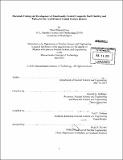Materials testing and development of functionally graded composite fuel cladding and piping for the Lead-Bismuth cooled nuclear reactor
Author(s)
Fray, Elliott Shepard
DownloadFull printable version (31.29Mb)
Other Contributors
Massachusetts Institute of Technology. Department of Nuclear Science and Engineering.
Advisor
Ronald G. Ballinger.
Terms of use
Metadata
Show full item recordAbstract
This study has extended the development of an exciting technology which promises to enable the Pb-Bi eutectic cooled reactors to operate at temperatures up to 650-700°C. This new technology is a functionally graded composite steel which resists high temperature LBE corrosion. This composite steel consists of a Fel2Cr2Si protective layer weld overlaid on a T91 steel and then drawn to fuel cladding and piping material. A series of tests and materials analysis were performed on the composite piping material. These tests / analysis included microstructural characterization, heat treatment optimization, creep and tensile testing, diffusion testing, and long term static corrosion tests. Although the composite fuel cladding was not available at the time of this study, all of the results from the piping material characterization are directly applicable to the fuel cladding material. It has been shown that the heat treated composite piping material exhibits mechanical properties in excess of the ASTM minimum standard for T91. This material also exhibits a conservative corrosion rate of< 22pm/yr in static Pb-Bi eutectic. This low corrosion rate will enable fuel cladding to have a 3.6 year lifetime and piping material a 36 year lifetime, if the static corrosion rate is equivalent to the flowing corrosion rate. This material has also been shown to have a very slow diffusion rate for chromium, with a chromium inter-diffusion zone of < 35um over the lifetime of the nuclear reactor. There still however exist several challenges to implementing this technology. The challenges include resolving the issue of cracking of the Fel2Cr2Si layer during tube drawing and increasing the high temperature stress / creep resistance of the structural T91 layer.
Description
Thesis (S.M.)--Massachusetts Institute of Technology, Dept. of Nuclear Science and Engineering, 2013. Cataloged from PDF version of thesis. Includes bibliographical references (pages 176-179).
Date issued
2013Department
Massachusetts Institute of Technology. Department of Nuclear Science and EngineeringPublisher
Massachusetts Institute of Technology
Keywords
Nuclear Science and Engineering.